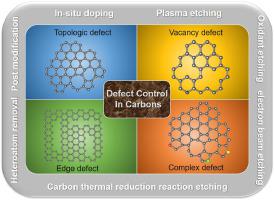EnergyChem ( IF 25.1 ) Pub Date : 2021-06-17 , DOI: 10.1016/j.enchem.2021.100059 Qilong Wu , Xuecheng Yan , Yi Jia , Xiangdong Yao

|
Defective carbon-based materials (DCMs) have recently been considered as one of the most promising alternatives to precious metal electrocatalysts owing to their irreplaceable advantages, such as environmentally friendly, low cost and high structural tunability. Despite remarkable progress has been achieved, grand challenges of their further development are still remained by the traditional “trial-and-error” approaches, mainly due to the lack of precise synthetic methodologies as well as in-depth understandings of active centers and underlying electrocatalytic mechanisms. Herein, this review will provide a comprehensive overview and perspective on the critical issues and possible solutions regarding the controllable synthesis of DCMs, with special emphasis on the theoretical guidance in designing complex carbon defect structures and operando characterizations in exploring “dynamic” active centers. More importantly, it will also highlight recent advances in the applications of DCMs for the cutting-edge “E-Refinery”, focusing on the electrochemical conversion of electricity into fuels and chemical building blocks (e.g., H2, O2, CH4, C2H4, CH3OH, C2H5OH, NH3 and other organic compounds). Finally, further challenges and opportunities are summarized to shed some light on the unexploited area and future directions in expectation of stimulating the broad interest of interdisciplinary researchers.
中文翻译:

有缺陷的碳基材料:可控合成和电化学应用
有缺陷的碳基材料(DCMs)由于其不可替代的优势,如环境友好、低成本和高结构可调性,最近被认为是贵金属电催化剂最有前途的替代品之一。尽管取得了显着进展,但传统的“试错法”方法仍然存在其进一步发展的巨大挑战,主要是由于缺乏精确的合成方法以及对活性中心和潜在电催化的深入理解机制。在此,本综述将对有关 DCM 可控合成的关键问题和可能的解决方案提供全面的概述和观点,特别强调在探索“动态”活性中心时设计复杂碳缺陷结构和操作特征的理论指导。更重要的是,它还将突出 DCM 在尖端“电子炼油厂”中的应用的最新进展,重点是将电能电化学转化为燃料和化学构件(例如,H2、O 2、CH 4、C 2 H 4、CH 3 OH、C 2 H 5 OH、NH 3和其他有机化合物)。最后,总结了进一步的挑战和机遇,以阐明未开发的领域和未来的方向,以期激发跨学科研究人员的广泛兴趣。



























 京公网安备 11010802027423号
京公网安备 11010802027423号